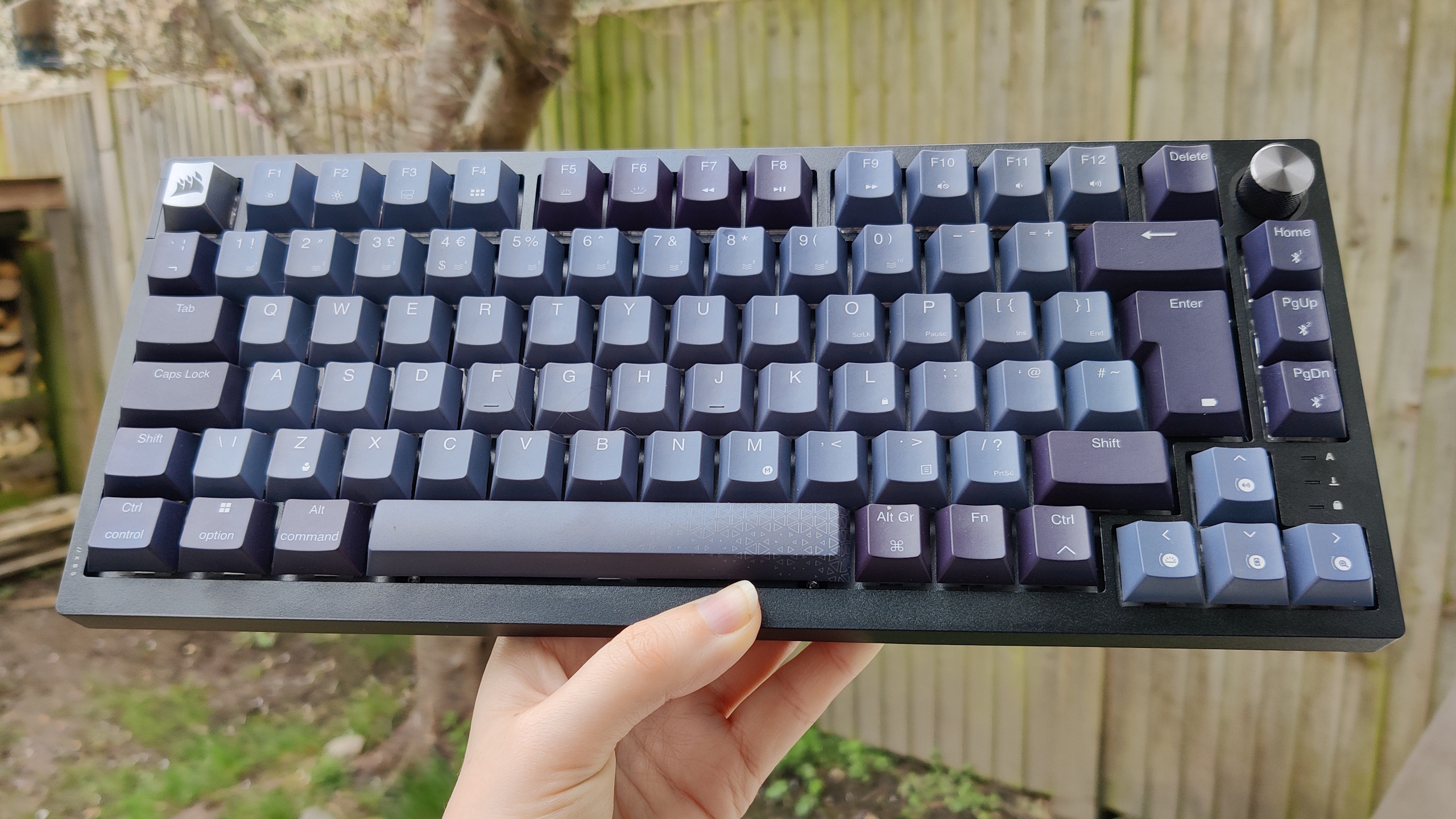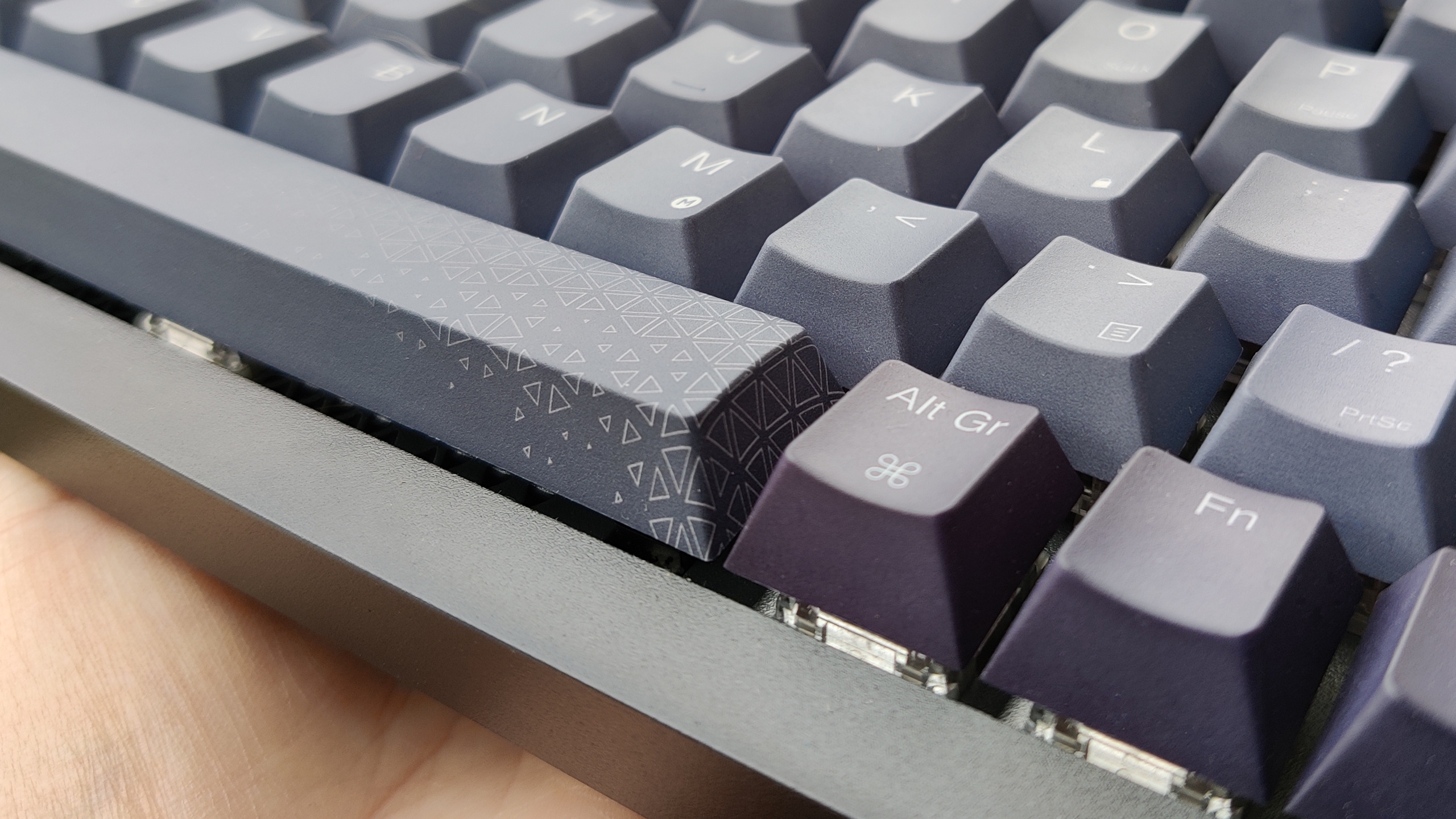
Enter the Corsair K65 Plus, the newest and once again confusingly named keyboard from Corsair. Although the name might suggest that the K65 Plus is a 65% board 'plus' some extras, it's actually just a 75% keyboard. Don't hold the backwards nomenclature against it, though. There's otherwise a heck of a lot to like about this compact keyboard. In a world where almost all the best wireless gaming keyboards have hundreds of hours of battery life, hot-swappable key switches and dedicated media controls, it'll have to pull something pretty special to get on the list, though.
Out of the box the K65 Plus looks like a lot of the other compact boards we've put on our best of list. It's not plagued with so much of the gamery aesthetic that some boards are, as it comes with a two-tone grey keycap set, and a backplate and spacebar decorated with Corsair's subtle polygonal pattern. There's a touch of metallic silver with the escape key—adorned with the Corsair ship logo—and a swanky metal dial in the top right that gives it some extra flair. You can tell it's going to be a high-end board just from the aesthetic, but there's more hiding under the hood.
What you can't tell from just looking at the K65 Plus is that it comes with hot-swappable key switches. If you aren't one for linear switches, there are sadly no other options for different key switches with the base model. So yeah, hot-swap switches are a great feature, but if you're still saving up for new switches and can't stand linears, the K65 Plus isn't going to be the best option for you. If you've already got some lying around, the likelihood is they'll fit the north-facing 5 pin slots, as these will fit most standard key switches. And if you just want to swap the caps, you're looking at the common-as-muck cross key stem and a Cherry profile. All pretty standard, so there's very little stress when it comes to swapping out.
The MLX Red linear key switches Corsair offers with base K65 Plus are super satisfying. They're soft with a good level of bounceback, and the 45g actuation force required down to just 1.9mm means I really don't have to press hard to get them going. Couple that with the soft silicone and foam lining and this is a damn quiet keyboard, too.

Size: 75%
Base: Hot-swappable
Switches: Corsair MLX Red Linear
Backlighting: Per key
Anti-ghosting: N-key rollover
Polling rate: 1,000Hz
Dimensions: 32 x 13.5 x 3.5mm
Weight: 942g | 33oz (w/out cable)
Connections: 2.4GHz | USB Type-C | Bluetooth
Cable: 180mm (braided)
Battery life: 266-hours (w/out lighting)
Warranty: 2 years
Price: £150 | $160
Typing on this keyboard is a joy, and shifting around in-game feels nice and smooth. Not to mention the stabilisers are sturdy, and tapping on the corner of the spacebar works just as well as the middle.
The most non-standard thing about the keyboard's layout is its separate Delete key sitting above the Backspace, while the Home, Page Up, and Page Down keys are neatly tucked in a column to the right. It takes a little getting used to, and I'm sure I've smashed Home more times than I have Delete when typing in a rush, but it's fine once you've gotten used to it. These are the kinds of things you have to suffer for the benefits a compact keyboard brings. Thankfully the fact it's a 75% board means you get the separate arrow keys, while keeping the size to a minimum. It means less faffing with the function key like you would with a 60% board.
The addition of dedicated media controls in the form of a dial is much appreciated, and is programmable even without downloading the iCue software. Whether in or outside of the software, however, you're stuck with only four function options: volume, page scrolling (horizontal/vertical), brightness and zoom. And while it's a little disappointing that you can't change what clicking the dial does, it's nice to see a keyboard that lets you go a little deeper into the lighting and other functions without the need for dedicated software. Personally, I've never had an issue with the iCue software itself. It sometimes eats up around 2% of my CPU usage, but it's got an easy-to-understand interface and the added benefit of PC monitoring graphs. In fact, for those with a full Corsair iCue Link cooling setup it does so much more than just reprogram buttons.



The Corsair K65 Plus is super portable being so compact, and while there is some heft to it it's still possible to tuck it into a backpack and take it away with you. Double so with its Mac and Windows connectivity switch and a marketed unlit battery life of around 266 hours. I've still got the 180mm braided cable tucked into the box since it came four days ago, and I've not had to plug it in once, even with the lighting going haywire. It's safe to say it wouldn't last 266 hours with the lights on, however. Once it hits the battery warning, the lights automatically switch off and won't come back on until you plug it in. It's a bit heavy handed but it keeps it going a little longer.
Changing the programmed settings and lighting on the fly is easy. There are four onboard profiles that you can switch through with the function keys and there's a button on the side to switch the lighting off altogether. Not that you'd want to. The per-key LED's handle colours I've seen plenty of peripherals stumble with, and it looks super vibrant with the slight shine on the backplate helping intensify it. It's a bit sad that the keycaps don't allow for shine through on the lettering, but they're at least PBT so they won't get shiny as quick as ABS and should last longer, and there's always the option to switch them out.

✅ You love having separate directional keys: This is a great size keyboard with the directional keys still intact. They're not all squished together and messing with the layout, either.
✅ You change devices a lot: The K65 Plus makes it super easy to switch between devices and even allows for up to three Bluetooth devices to be connected at once.
❌ You're a non-linear switch liker trying to save money: You will have to spend out on a whole new set of key switches, since there's no option to nab anything but linear switches with the base model.
❌ You need macro keys: This is a little more barebones than some, bar the media dial, so don't expect too many extra gamer-centric features bar standard 1000Hz polling, NKRO and anti-ghosting.
All in all the K65 Plus is a smashing and sturdy board with a subtle aesthetic and loads of the worthwhile features expected from high-end boards. It doesn't push too far into the strange compact layout territory and with a price that matches the features. The main disappointments for me are its lack of key switch options with the base board, and the limited functionality on the media dial, but none of that changes the fact it offers everything you'd want from a $160/£150 keyboard.
Basically, the K65 Plus is a great mid-tier board with very little to complain about.
The Corsair K65 Plus has a little more space to breathe, layout-wise, compared to the much more affordable Keychron K2 which comes in at $69. It also has a few more features such as that little media control knob and hot-swappable switches, but even the Keychron base model comes with various switch options. On the other hand, compare the K65 Plus to something like the Asus ROG Azoth—another hot-swappable keyboard at the higher end of the market—and you might not be getting as many dedicated media controls or a fancy little display, but for half the price you get just as much keyboard and almost double the battery life.







